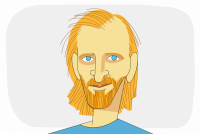Using human shields, attacking medical teams and hospitals, shooting at civilians waving white flags. A new report by Physicians for Human Rights authored by a team of international medical experts documents shocking testimonies of victims and presents new evidence from Operation Protective Edge in Gaza.
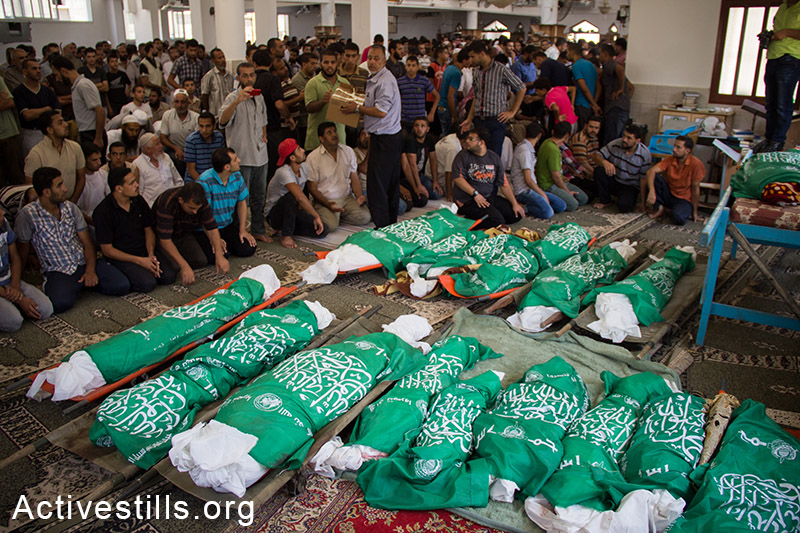
The thing that shocked me most in a new report on Gaza by international experts was the IDF’s “double tap” attacks. Other findings in the report have already been written about, some of them during the war, “Operation Protective Edge,” here on +972. We reported about the shooting at civilians in the Khuza’a neighborhood, the use of human shields, destroying hospitals, how Gazans felt they had no safe place to run to, the dozens of families that were simply eliminated, and more. But the “double taps” — that is entirely new.
The team of medical experts that authored the report visited Gaza three times as a delegation of Physicians for Human Rights (PHR). They collected testimonies from dozens of wounded and from medical teams, documented the army’s terrifying actions during the war. At least 15 people testified about and described incidents in which the army bombed a target, and then — after a short pause or immediately after — bombed it again. The result was especially deadly: family members, neighbors, passersby and/or medical and emergency teams that arrived to help the wounded and extract bodies from the rubble, were bombed themselves, were killed or wounded.
Read the full report here
“This is a separate phenomenon from that of the so- called ‘roof-tap[s],” explain the authors of the report, which in a separate section addresses the “roof tap” warning strikes — which are small bombs that aren’t supposed to fell buildings. The “double tap” is something else. For Israelis it is reminiscent of our own traumas, like the Beit Lid double suicide bombing and other terror attacks that used the same tactic. According to the team of experts, that is how the Israeli army operated in Gaza.
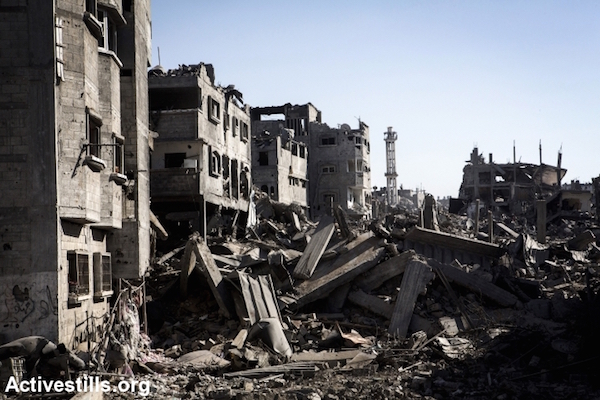
The Red Crescent described the “double tap” practice as one of the central factors behind the deaths and injuries of their medical teams. A total of 23 medical personnel, 16 of them on duty, were killed during the war; another 83 were wounded. According to the team of experts, 45 ambulances were damaged by army attacks, including an ambulance station, 17 hospitals and 56 clinics that were entirely destroyed or damaged. And all that was after the UN transmitted to Israel the precise coordinates of every medical facility in the Gaza Strip.
The importance of bringing the team of medical experts was already apparent to PHR during the war. “We opened emergency hotlines and 24 hours a day we received calls from people who needed to be evacuated to hospitals,” says Mahmoud Abu Arisha, one of the directors of PHR’s occupied territories department. “Families were trapped in their homes where there was shooting outside. They lost close family members and they couldn’t go look for them. Time after time we called the [IDF’s District Coordination and Liaison Office] for Gaza but we felt like they weren’t hearing us and they didn’t understand what we were saying. The feeling was that our intervention wasn’t effective at all.”
The helplessness of their attempts to assist the injured in Gaza resulted in PHR inviting the experts (the full list of the team members is listed below), who entered Gaza for the first time in Gaza, during the fighting, and then another two times after the war. They also interviewed wounded Gaza’s who were hospitalized in Israel, Nablus and Amman.
Read +972’s ‘Story of the Year’: Gaza
In their report the medical experts write that of the 68 wounded with whom they spoke, 64 percent were wounded in their homes or in their neighbors’ or families’ homes. Another 28 percent were wounded while trying to flee. Most of those interviewed described an impossible situation in which they were attacked without any prior warning, or in which the warnings that weren’t followed through, or warnings the were followed through — but from which there was nowhere to run. That is, either because there were warnings of impending attacks almost everywhere in Gaza, or because the paths of escape were blocked. As Mahmoud Ismail wrote on our Hebrew-language sister site Local Call, during the fighting, there were very few things Gazans could do to save their own lives.
According to the report, over 2,100 Palestinians were killed during the war, 70 percent of whom were civilians who weren’t involved in combat, in addition to 67 Israeli soldiers and six Israeli civilians, including one child. Among the Palestinians killed, over 500 were minors, according to UN data cited in the report — and at least 142 families lost at least three members in individual attacks on their homes. The army has still not provided an explanation of its change in policy relating to the assassination of entire families, a practice that was banned in the past save for extraordinary circumstances. During Protective Edge it was common practice.
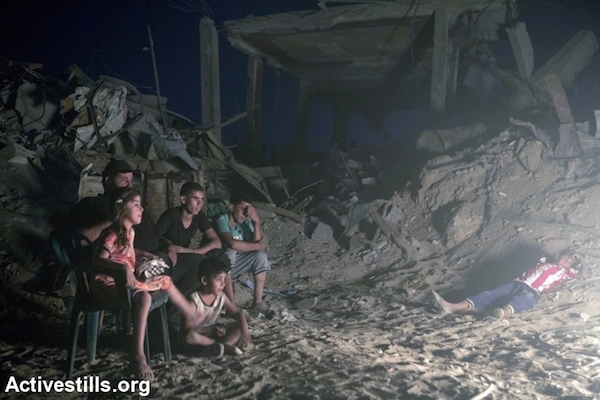
An entire section of the report is dedicated to investigating the intensive military operation in the Khuza’a neighborhood in July. On July 23, a few hundred residents who had ignored the army’s earlier orders to leave the neighborhood decided that they had to find a way to leave for a safer place — together. They advanced in a group while waving white flags. Nevertheless, soldiers opened fire toward them, wounding dozens. According to the report, a 16-year-old wheelchair-bound girl was killed in the shooting.
In another incident a few days later, Israeli soldiers took over a home in the neighborhood and killed the father of the household, according to other family members. Next, they say, the soldiers made the other male family members stand in front of the windows; the soldiers stood behind, rested their weapons on their shoulders and shot outside — using them as human shields. They full testimonies of those two incidents are published below. The Israeli army is currently investigating the use of another Palestinian boy as a human shield, which was first reported by +972’s Samer Badawi.
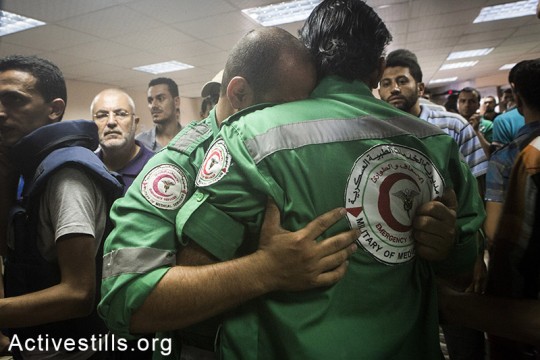
“The discourse surrounding Gaza is often times limited to the question of whether there were war crimes — but as far as I’m concerned, that’s not the issue,” says PHR director of public outreach Hadas Ziv. “The more important question is why do we take for granted that such things happen every two years. The report’s conclusion, in my opinion, is that you don’t need to fix this or that about the army’s actions, but that we need to prevent the next war. I want them to think about what they’re doing to the people there and about what it’s doing to our soldiers when they decide to go to war.”
Alongside the publication of the report, PHR demanded that Prime Minister Benjamin Netanyahu establish an official investigative commission to look at the army’s actions in Gaza. The IDF Spokesperson had not responded to the report at the time of publication.
The testimony of a paramedic recalling how the Israeli army fired on his ambulance (collected by PHR):
The team of international medical experts who authored the report are: Dr. Jutta Bachmann, an expert on forensic evidence, rehabilitation and public health; Prof. Laurel Baldwin-Ragaven, an expert on public health and human rights, and the psychosocial impact of the attacks; Hans Petter Hougen, a forensic pathologist; Dr. Karen L. Kelly, an expert in forensic and cardiovascular pathology; Dr. Jennifer Leaning, a professor of health and human rights and a veteran human rights investigator; Dr. Önder Özkalipci, an expert on forensic evidence; Dr. Louis Reynolds, an expert in pediatric intensive care; Alicia Vacas, RN.
Testimony (p. 82): Shooting at civilians waving white flags
That morning, many of the remaining people in the town made a collective decision that it would be safest to gather in a common area and leave the town as a large group, walking out together, holding white flags to signify that they were civilians. People contacted each other by phone and young men were sent to the homes where people were sheltering, to inform them of this decision.
According to Samia Abu Daka, who participated in the mass march, 500 people took part. Other testimonies put the number as high as 3000. They left the area of the clinic at 07:30, holding white bed-sheets, clothes tied to sticks, or any other white material including white plastic bags, and walked up the main road, which divides the town and leads westward towards the town of Khan Younis, calling ‘peaceful, peaceful.’
The group neared some tanks and soldiers. According to Dr. Kamal Qdeih, who was in the front line of the group with his wife, grandfather and children, he heard an announcement by megaphone saying: “You must return, you do not have permission to leave this area”. Soldiers and snipers were stationed on the rooftops of and inside houses along the streets, and the group came under gunfire. Dr. Qdeih says he saw Israeli soldiers with weapons shooting at the group.
According to Dr. Qdeih, about 31 people were injured by bullets and/or shrapnel.
…
A relative of Dr. Qdeih, a disabled, wheelchair-bound, 16-year-old girl with a seizure disorder, was left alone when the shooting started. Her brother was pushing the wheelchair in the large group but when the shooting started he ran away and left her. Later that day Dr. Qdeih tried to get ICRC to evacuate her. However, she died and her charred body was found by her family on 1 August 2014 in the street.
Testimony (p. 89): Execution of a civilian, human shields
Ramadan’s father opened the front door of the house, thinking that the soldiers were standing at the main entrance to the house – but they were already in the house behind him, having entered through the side door. Ramadan’s father was ordered to turn around from the front door, which he did. As he began to climb the few stairs from the front door towards the side door, in the direction of the soldiers, he was shot twice by one Israeli soldier at a distance of about two meters. The projectiles perforated his chest and the glass of the front door. He died immediately in front of his family.
…
The young men were taken to the second floor. The Israeli soldiers had removed the glass from the windows facing the street. Two of the young men were then placed in front of the open windows in each room. The Israeli soldiers placed the rifle barrels onto the men’s shoulders and fired out the windows. They did not fire continuously, but now and then over approximately one hour. Meanwhile the Israeli soldiers were laughing and joking. The rifle barrels were alternately placed on the left and the right shoulder of Ramadan (probably the same regarding the other men) and Ramadan was ordered to stand completely still. This lasted for about 8 hours, during which time Ramadan received no food or drink.
This article was first published on +972’s Hebrew-language sister site, Local Call. Read it in Hebrew here.

